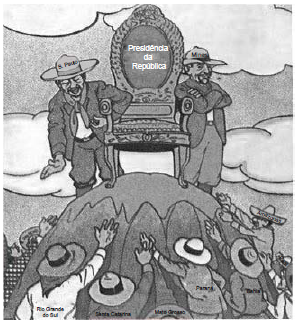Questões de Vestibular FATEC 2010 para Vestibular, Prova 01
Foram encontradas 54 questões
As cidades-Estado [...] eram muito diferentes entre si: nas dimensões territoriais, nas riquezas, em suas histórias particulares e nas diferentes soluções obtidas ao longo dos séculos para os conflitos de interesses entre seus componentes. A maioria delas nunca ultrapassou a dimensão de pequenas unidades territoriais, abrigando alguns milhares de habitantes – não mais do que 5 mil, quase todos envolvidos com o meio rural. Outras, de porte médio, chegaram a congregar 20 mil pessoas. Algumas poucas, portos comerciais ou centros de grandes impérios, atingiram a dimensão de verdadeiras metrópoles, com mais de 100 mil habitantes [...]. (GUARINELLO, Norberto Luiz. Cidades-Estado na Antiguidade Clássica. In: PINSKY, Jaime; PINSKY, Carla Bassanezi (Orgs.). História da cidadania. São Paulo: Contexto, 2008. p. 30.)
De acordo com o texto, na Grécia antiga, as cidades-Estado
Deus criou essas gentes infinitas, de todas as espécies, mui simples, sem finura, sem astúcia, sem malícia, mui obedientes e mui fiéis a seus Senhores naturais e aos espanhóis a que servem; mui humildes, mui pacientes, mui pacíficas e amantes da paz, sem contendas, sem perturbações, sem querelas, sem questões, sem ira, sem ódio e de forma alguma desejosos de vingança. AS CASAS. Frei Bartolomé de. O Paraíso Destruído. A sangrenta história da conquista da América Espanhola. Porto Alegre: L&PM Editores S/A, 1996. p. 24.)
Frei Bartolomé de Las Casas foi um importante observador e defensor das populações indígenas das terras recém-descobertas. Sobre esse período, séculos XVI e XVII, e sobre o texto é correto afirmar que na América espanhola,
A grande marca deixada pelos paulistas na vida colonial do século XVII foram as bandeiras. , (FAUSTO, Boris. História concisa do Brasil. São Paulo: Imprensa Oficial e Edusp, 2001. p. 51.)
A afirmação pode ser considerada correta, pois
Considere a charge a seguir para responder à questão.

A FÓRMULA DEMOCRÁTICA OS DETENTORES – TENHAM PACIÊNCIA, MAS AQUI NÃO SOBE MAIS NINGUÉM!
(http://novahistorianet.blogspot.com/2009/01/republica-velha. html. Acesso em 05.03.2010.)
A charge do caricaturista e ilustrador gaucho Storni, publicada na revista Careta, em 1925, é uma crítica
referente
No dia 26 de abril, pela manhã, os pilotos concretizaram a missão de massacrar Guernica e Durango com bombas incendiárias. A estratégia perdurou durante todo o mês de maio. Em 19 de junho de 1937, Bilbao cai. Os bascos insatisfeitos tiveram que partir para o norte dos Pirineus ou para o exílio. RICHARD, Lionel. Guernica, agonia de uma guerra. Le monde Diplomatique. Abril de 2007.) (http://diplo.org.br/2007-04,a1541. Acesso em 08.03.2010.)
Os ataques descritos fazem parte do contexto
[...] Meu Brasil!... Que sonha com a volta do irmão do Henfil. Com tanta gente que partiu num rabo de foguete. Chora! A nossa pátria, mãe gentil choram Marias e Clarices no solo do Brasil. Mas sei, que uma dor assim pungente não há de ser inutilmente a esperança... [...] ( http://letras.terra.com.br/elis-regina/45679/. Acesso em 06.03.2010)
A música O bêbado e a equilibrista, escrita por João Bosco e Aldir Blanc, se tornou o símbolo
I. O produto da reação é um composto iônico. II. O átomo de xenônio perde elétron transformando-se em um cátion. III. O número de prótons do núcleo do átomo de xenônio diminui de uma unidade.
É correto o que se afirma em
Massas molares em g/mol: Xe = 131; Pt = 195; F = 19
Sendo assim, considerando uma piscina de formato retangular que tenha 10 m de comprimento, 5 m de largura e 2 m de profundidade, quando cheia de água,a massa máxima de sulfato de cobre que poderá se dissolver é, em gramas, igual a
Dado: 1m3 = 1 000 L
Caso a combustão desse combustível seja usada para gerar energia elétrica, a massa de hidrogênio, que deve ser queimada para fornecer os 200 kWh que são consumidos por mês em determinada residência, será aproximadamente, em quilogramas,
Dados: 1 kWh = 3,6 x 103 kJ Considere que apenas 50% da energia da combustão seja convertida em energia elétrica.
 , de medida igual a 2; • o diâmetro
, de medida igual a 2; • o diâmetro  perpendicular à reta
perpendicular à reta  ; • o ponto C pertencente à reta
; • o ponto C pertencente à reta  .
.

Nestas condições, no triângulo ABD, a medida do lado
 é
é